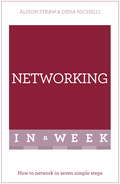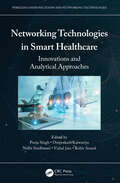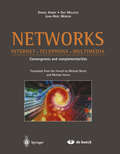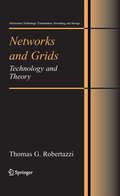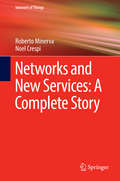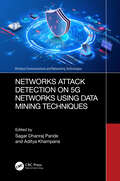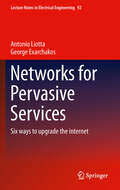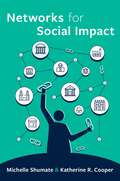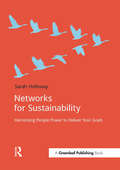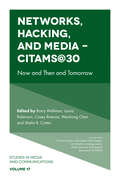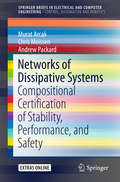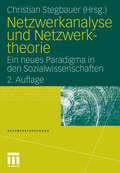- Table View
- List View
Networking -- ICN 2005: 4th International Conference on Networking, Reunion Island, France, April 17-21, 2005, Proceedings, Part I (Lecture Notes in Computer Science #3420)
by Pascal Lorenz Petre DiniThe International Conference on Networking (ICN 2005) was the fourth conf- ence in its series aimed at stimulating technical exchange in the emerging and important ?eld of networking. On behalf of the International Advisory C- mittee, it is our great pleasure to welcome you to the proceedings of the 2005 event. Networking faces dramatic changes due to the customer-centric view, the venue of the next generation networks paradigm, the push from ubiquitous n- working,andthenewservicemodels.Despitelegacyproblems,whichresearchers and industry are still discovering and improving the state of the art, the ho- zon has revealed new challenges that some of the authors tackled through their submissions. InfactICN2005wasverywellperceivedbytheinternationalnetworkingc- munity. A total of 651 papers from more than 60 countries were submitted, from which 238 were accepted. Each paper was reviewed by several members of the Technical Program Committee. This year, the Advisory Committee revalidated various accepted papers after the reviews had been incorporated. We perceived a signi?cant improvement in the number of submissions and the quality of the submissions. TheICN2005programcoveredavarietyofresearchtopicsthatareofcurrent interest,startingwithGridnetworks,multicasting,TCPoptimizations,QoSand security, emergency services, and network resiliency. The Program Committee selected also three tutorials and invited speakers that addressed the latest - search results from the international industries and academia, and reports on ?ndings from mobile, satellite, and personal communications related to 3rd- and 4th-generation research projects and standardization.
Networking In A Week: How To Network In Seven Simple Steps (TYW)
by Dena Michelli Alison StrawNetworking just got easierNetworking is a word that is firmly embedded in our vocabulary. It is not unusual to hear the word used to describe a range of activities and behaviours.The activities of a successful networker are often focussed on outcomes. Our research and observations suggest that successful networkers build their networks by developing close relationships with work colleagues, professional communities and associations and virtually, through social and professional networking sites, referrals and references from friends or colleagues.The behaviours of a successful networker are often social. Successful networkers may be considered to be gregarious; when you observe them, it becomes clear they build relationships through empathic connections, being respectful, purposeful and reciprocal relationships that are founded on principles such as 'do as you would be done by'.Individuals respond to the word network in different ways. However you respond to the word, networks can make the difference for you personally and professionally. Networking In A Week is designed to help you understand, benefit from and develop your network.Each of the seven chapters in Networking In A Week covers a different aspect:- Sunday: Networks and networking- Monday: Personal networks- Tuesday: Organizational networks- Wednesday: Professional networks- Thursday: Networking for career development- Friday: Social networking- Saturday: Simple steps to networking success
Networking, Intelligent Systems and Security: Proceedings of NISS 2021 (Smart Innovation, Systems and Technologies #237)
by Mohamed Ben Ahmed Horia-Nicolai L. Teodorescu Tomader Mazri Parthasarathy Subashini Anouar Abdelhakim BoudhirThis book gathers best selected research papers presented at the International Conference on Networking, Intelligent Systems and Security, held in Kenitra, Morocco, during 01–02 April 2021. The book highlights latest research and findings in the field of ICT, and it provides new solutions, efficient tools, and techniques that draw on modern technologies to increase urban services. In addition, it provides a critical overview of the status quo, shares new propositions, and outlines future perspectives in networks, smart systems, security, information technologies, and computer science.
Networking Simulation for Intelligent Transportation Systems: High Mobile Wireless Nodes
by Benoit Hilt Marion Berbineau Alexey Vinel Alain PirovanoThis book studies the simulation of wireless networking in the domain of Intelligent Transportation Systems (ITS) involving aircraft, railway and vehicular communication. On this subject, particular focus is placed on effective communication channels, mobility modeling, multi-technology simulation and global ITS simulation frameworks. Networking Simulation for Intelligent Transportation Systems addresses the mixing of IEEE802.11p and LTE into a dedicated simulation environment as well as the links between ITS and IoT; aeronautical mobility and VHD Data Link (VDL) simulation; virtual co-simulation for railway communication and control-command; realistic channel simulation, mobility modeling and autonomic simulation for VANET and quality metrics for VANET. The authors intend for this book to be as useful as possible to the reader as they provide examples of methods and tools for running realistic and reliable simulations in the domain of communications for ITS.
Networking Simulation for Intelligent Transportation Systems: High Mobile Wireless Nodes
by Benoit Hilt Marion Berbineau Alexey Vinel Alain PirovanoThis book studies the simulation of wireless networking in the domain of Intelligent Transportation Systems (ITS) involving aircraft, railway and vehicular communication. On this subject, particular focus is placed on effective communication channels, mobility modeling, multi-technology simulation and global ITS simulation frameworks. Networking Simulation for Intelligent Transportation Systems addresses the mixing of IEEE802.11p and LTE into a dedicated simulation environment as well as the links between ITS and IoT; aeronautical mobility and VHD Data Link (VDL) simulation; virtual co-simulation for railway communication and control-command; realistic channel simulation, mobility modeling and autonomic simulation for VANET and quality metrics for VANET. The authors intend for this book to be as useful as possible to the reader as they provide examples of methods and tools for running realistic and reliable simulations in the domain of communications for ITS.
Networking Technologies in Smart Healthcare: Innovations and Analytical Approaches (Wireless Communications and Networking Technologies)
by Pooja Singh Omprakash Kaiwartya Nidhi Sindhwani Vishal Jain Rohit AnandThis text provides novel smart network systems, wireless telecommunications infrastructures, and computing capabilities to help healthcare systems using computing techniques like IoT, cloud computing, machine and deep learning Big Data along with smart wireless networks. It discusses important topics, including robotics manipulation and analysis in smart healthcare industries, smart telemedicine framework using machine learning and deep learning, role of UAV and drones in smart hospitals, virtual reality based on 5G/6G and augmented reality in healthcare systems, data privacy and security, nanomedicine, and cloud-based artificial intelligence in healthcare systems. The book: • Discusses intelligent computing through IoT and Big Data in secure and smart healthcare systems. • Covers algorithms, including deterministic algorithms, randomized algorithms, iterative algorithms, and recursive algorithms. • Discusses remote sensing devices in hospitals and local health facilities for patient evaluation and care. • Covers wearable technology applications such as weight control and physical activity tracking for disease prevention and smart healthcare. This book will be useful for senior undergraduate, graduate students, and academic researchers in areas such as electrical engineering, electronics and communication engineering, computer science, and information technology. Discussing concepts of smart networks, advanced wireless communication, and technologies in setting up smart healthcare services, this text will be useful for senior undergraduate, graduate students, and academic researchers in areas such as electrical engineering, electronics and communication engineering, computer science, and information technology. It covers internet of things (IoT) implementation and challenges in healthcare industries, wireless network, and communication-based optimization algorithms for smart healthcare devices.
Networking Technologies in Smart Healthcare: Innovations and Analytical Approaches (Wireless Communications and Networking Technologies)
by Pooja Singh Omprakash Kaiwartya Nidhi Sindhwani Vishal Jain Rohit AnandThis text provides novel smart network systems, wireless telecommunications infrastructures, and computing capabilities to help healthcare systems using computing techniques like IoT, cloud computing, machine and deep learning Big Data along with smart wireless networks. It discusses important topics, including robotics manipulation and analysis in smart healthcare industries, smart telemedicine framework using machine learning and deep learning, role of UAV and drones in smart hospitals, virtual reality based on 5G/6G and augmented reality in healthcare systems, data privacy and security, nanomedicine, and cloud-based artificial intelligence in healthcare systems. The book: • Discusses intelligent computing through IoT and Big Data in secure and smart healthcare systems. • Covers algorithms, including deterministic algorithms, randomized algorithms, iterative algorithms, and recursive algorithms. • Discusses remote sensing devices in hospitals and local health facilities for patient evaluation and care. • Covers wearable technology applications such as weight control and physical activity tracking for disease prevention and smart healthcare. This book will be useful for senior undergraduate, graduate students, and academic researchers in areas such as electrical engineering, electronics and communication engineering, computer science, and information technology. Discussing concepts of smart networks, advanced wireless communication, and technologies in setting up smart healthcare services, this text will be useful for senior undergraduate, graduate students, and academic researchers in areas such as electrical engineering, electronics and communication engineering, computer science, and information technology. It covers internet of things (IoT) implementation and challenges in healthcare industries, wireless network, and communication-based optimization algorithms for smart healthcare devices.
Networks: Internet · Telephony · Multimedia
by Daniel Hardy Guy Malleus Jean-Noel MereurThis handbook delivers a complete and practice-oriented overview of the fundamentals of today's telecommunications networks and the future prospects for next generation networks (NGN). The very clear and concise text is supplemented by many colour illustrations and embedded into a functional four-colour layout.
Networks and Communications: Proceedings of the Fifth International Conference on Networks & Communications (Lecture Notes in Electrical Engineering #284)
by Natarajan Meghanathan Dhinaharan Nagamalai Sanguthevar RajasekaranThis book covers theory, methodology and applications of computer networks, network protocols and wireless networks, data communication technologies, and network security. The book is based on the proceedings from the Fifth International Conference on Networks & Communications (NetCom). The proceedings will feature peer-reviewed papers that illustrate research results, projects, surveys and industrial experiences that describe significant advances in the diverse areas of computer networks & communications.
Networks and Grids: Technology and Theory (Information Technology: Transmission, Processing and Storage)
by Thomas G. RobertazziThis useful volume adopts a balanced approach between technology and mathematical modeling in computer networks, covering such topics as switching elements and fabrics, Ethernet, and ALOHA design. The discussion includes a variety of queueing models, routing, protocol verification and error codes and divisible load theory, a new modeling technique with applications to grids and parallel and distributed processing. Examples at the end of each chapter provide ample material for practice. This book can serve as an text for an undergraduate or graduate course on computer networks or performance evaluation in electrical and computer engineering or computer science.
Networks and New Services: A Complete Story (Internet of Things)
by Roberto Minerva Noel CrespiThis book shines a spotlight on software-centric networks and their emerging service environments. The authors examine the road ahead for connectivity, for both humans and 'things', considering the rapid changes that have shaken the industry. The book analyses major catalytic shifts that are shaping the communications world: softwarization, virtualization, and cloud computing. It guides the reader through a maze of possible architectural choices, driven by discriminating and sometimes conflicting business considerations. The new ICT capabilities lead us toward smarter environments and to an ecosystem where applications are backed up by shared networking facilities, instead of networks that support their own applications. Growing user awareness is a key driver towards the softwarization process.Softwarization disrupts the current status quo for equipment, development, networks, operations and business. It changes radically the value chain and the involved stakeholders. The dilemma is between a 'slow burn' traditional step-by-step approach and a bold transformation of the whole infrastructure and business models. This book is essential reading for those seeking to build user-centric communication networks that support independent agile and smart applications.“The book gives an insightful account of modern telecom networks, pinpointing the radical transformations of the last 20 years. This is the perfect read for those who are interested in the grand challenges of networks and in the socio-economic reasons why the telecom industry to embrace the Internet of Things and cyber-physical systems.”Prof. Antonio Liotta, Eindhoven University of Technology“This book fulfills an urgent need to thoroughly analyze the entanglement of network and software architectures by taking into account the increasing softwarization. It highlights important issues behind today’s business models and opens the road for sustainable future approaches to provide user appreciated valuable services.” Dr. Eng. Hendrik Berndt, former CTO of NTT DOCOMO Communications Laboratories Europe
Networks Attack Detection on 5G Networks using Data Mining Techniques (Wireless Communications and Networking Technologies)
by Sagar Dhanraj Pande Aditya KhampariaArtificial intelligence (AI) and its applications have risen to prominence as one of the most active study areas in recent years. In recent years, a rising number of AI applications have been applied in a variety of areas. Agriculture, transportation, medicine, and health are all being transformed by AI technology. The Internet of Things (IoT) market is thriving, having a significant impact on a wide variety of industries and applications, including e-health care, smart cities, smart transportation, and industrial engineering. Recent breakthroughs in artificial intelligence and machine learning techniques have reshaped various aspects of artificial vision, considerably improving the state of the art for artificial vision systems across a broad range of high-level tasks. As a result, several innovations and studies are being conducted to improve the performance and productivity of IoT devices across multiple industries using machine learning and artificial intelligence. Security is a primary consideration when analyzing the next generation communication network due to the rapid advancement of technology. Additionally, data analytics, deep intelligence, deep learning, cloud computing, and intelligent solutions are being employed in medical, agricultural, industrial, and health care systems that are based on the Internet of Things. This book will look at cutting-edge Network Attacks and Security solutions that employ intelligent data processing and Machine Learning (ML) methods.This book: Covers emerging technologies of network attacks and management aspects. Presents artificial intelligence techniques for networks and resource optimization, and toward network automation, and security. Showcases recent industrial and technological aspects of next-generation networks Illustrates artificial intelligence techniques to mitigate cyber-attacks, authentication, and authorization challenges. Explains smart, and real-time monitoring services, multimedia, cloud computing, and information processing methodologies in 5G networks. It is primarily for senior undergraduates, graduate students and academic researchers in the fields of electrical engineering, electronics and communication engineering, computer engineering, and information technology.
Networks Attack Detection on 5G Networks using Data Mining Techniques (Wireless Communications and Networking Technologies)
Artificial intelligence (AI) and its applications have risen to prominence as one of the most active study areas in recent years. In recent years, a rising number of AI applications have been applied in a variety of areas. Agriculture, transportation, medicine, and health are all being transformed by AI technology. The Internet of Things (IoT) market is thriving, having a significant impact on a wide variety of industries and applications, including e-health care, smart cities, smart transportation, and industrial engineering. Recent breakthroughs in artificial intelligence and machine learning techniques have reshaped various aspects of artificial vision, considerably improving the state of the art for artificial vision systems across a broad range of high-level tasks. As a result, several innovations and studies are being conducted to improve the performance and productivity of IoT devices across multiple industries using machine learning and artificial intelligence. Security is a primary consideration when analyzing the next generation communication network due to the rapid advancement of technology. Additionally, data analytics, deep intelligence, deep learning, cloud computing, and intelligent solutions are being employed in medical, agricultural, industrial, and health care systems that are based on the Internet of Things. This book will look at cutting-edge Network Attacks and Security solutions that employ intelligent data processing and Machine Learning (ML) methods.This book: Covers emerging technologies of network attacks and management aspects. Presents artificial intelligence techniques for networks and resource optimization, and toward network automation, and security. Showcases recent industrial and technological aspects of next-generation networks Illustrates artificial intelligence techniques to mitigate cyber-attacks, authentication, and authorization challenges. Explains smart, and real-time monitoring services, multimedia, cloud computing, and information processing methodologies in 5G networks. It is primarily for senior undergraduates, graduate students and academic researchers in the fields of electrical engineering, electronics and communication engineering, computer engineering, and information technology.
Networks for Pervasive Services: Six Ways to Upgrade the Internet (Lecture Notes in Electrical Engineering #92)
by Antonio Liotta George ExarchakosReaders will progress from an understanding of what the Internet is now towards an understanding of the motivations and techniques that will drive its future.
Networks for Social Impact
by Michelle Shumate Katherine R. CooperA broad review of how nonprofits, businesses, and governments work together to tackle social problems Networks for Social Impact takes a systems approach to explain how and when networks make a social impact. Michelle Shumate and Katherine R. Cooper argue that network design and management is not a one-size-fits-all formula. Instead, they show that the type of social issue, the mechanism for social impact, environment, and resources available each determine appropriate choices. Drawing on research from public administration, psychology, business, network science, social work, and communication, this book synthesizes what we know about how to best design and manage networks. It includes illustrations from thirty original case studies which describe groups of organizations addressing issues such as gender-based violence, educational outcomes, senior care, veterans' services, mental health and wellness, and climate change. Additionally, the volume examines critical issues that leaders address in creating and managing networks, including social issue analysis, network governance, securing and managing funding, dealing with power and conflict, using data effectively, and managing change. Each chapter includes tools for network leaders to use to handle these issues. This book is neither an overly idealistic, pro-collaboration account of the benefits of network approaches, nor is it a critical view of these efforts. Instead, this clear and concise volume highlights the opportunities and challenges of networks.
Networks for Social Impact
by Michelle Shumate Katherine R. CooperA broad review of how nonprofits, businesses, and governments work together to tackle social problems Networks for Social Impact takes a systems approach to explain how and when networks make a social impact. Michelle Shumate and Katherine R. Cooper argue that network design and management is not a one-size-fits-all formula. Instead, they show that the type of social issue, the mechanism for social impact, environment, and resources available each determine appropriate choices. Drawing on research from public administration, psychology, business, network science, social work, and communication, this book synthesizes what we know about how to best design and manage networks. It includes illustrations from thirty original case studies which describe groups of organizations addressing issues such as gender-based violence, educational outcomes, senior care, veterans' services, mental health and wellness, and climate change. Additionally, the volume examines critical issues that leaders address in creating and managing networks, including social issue analysis, network governance, securing and managing funding, dealing with power and conflict, using data effectively, and managing change. Each chapter includes tools for network leaders to use to handle these issues. This book is neither an overly idealistic, pro-collaboration account of the benefits of network approaches, nor is it a critical view of these efforts. Instead, this clear and concise volume highlights the opportunities and challenges of networks.
Networks for Sustainability: Harnessing people power to deliver your goals (DoShorts)
by Sarah HollowayIf your company has an ambitious set of sustainability goals, you’ll already know that they can’t be achieved from the safety of global headquarters. What you need is a network: a small army of people from across the business who know their department, country or brand inside out, and who can find the right way to embed sustainability.Change, when it happens, is usually driven locally, taking into account the priorities, environment and culture of each business area. If you’ve spent a long time persuading senior management that the sustainability agenda is business-critical, it’s difficult to place the delivery of your precious goals in the hands of others. But you can’t be everywhere at once!Networks for Sustainability gives you the tools to review and improve your sustainability network, whether you’re revitalizing a group of champions or setting up your network from scratch.
Networks for Sustainability: Harnessing people power to deliver your goals (DoShorts)
by Sarah HollowayIf your company has an ambitious set of sustainability goals, you’ll already know that they can’t be achieved from the safety of global headquarters. What you need is a network: a small army of people from across the business who know their department, country or brand inside out, and who can find the right way to embed sustainability.Change, when it happens, is usually driven locally, taking into account the priorities, environment and culture of each business area. If you’ve spent a long time persuading senior management that the sustainability agenda is business-critical, it’s difficult to place the delivery of your precious goals in the hands of others. But you can’t be everywhere at once!Networks for Sustainability gives you the tools to review and improve your sustainability network, whether you’re revitalizing a group of champions or setting up your network from scratch.
Networks, Hacking and Media - CITAMS@30: Now and Then and Tomorrow (Studies in Media and Communications #17)
by Barry Wellman Laura Robinson Casey Brienza Wenhong Chen Shelia CottenSponsored by the Communication, Information Technologies, and Media Sociology section of the American Sociological Association (CITAMS), this volume celebrates the section's thirtieth anniversary. Lead editor Barry Wellman joins forces with former and current CITAMS chairs Wenhong Chen, Shelia Cotten, and Laura Robinson, as well as Casey Brienza, founder of the Media Sociology Preconference, to look back at the history of the section, review some of its most important themes, and set the agenda for future discussion. Alongside its sister volume, The "M" in CITAMS@30: Media Sociology, this valuable book shows the impact CITAMS has had, and continues to have, on academic and public discourse. Featuring leading scholars in the fields of sociology of communication, information technologies and media, it reveals how the section had transcended disciplinary boundaries, and demonstrates how it holds the skills to address some of the biggest challenges of our digital age. It is essential reading for all those interested in both the story of CITAMS to date, and the role it will play in the future.
Networks, Hacking and Media - CITAMS@30: Now and Then and Tomorrow (Studies in Media and Communications #17)
by Barry Wellman Laura Robinson Casey Brienza Wenhong Chen Shelia R. CottenSponsored by the Communication, Information Technologies, and Media Sociology section of the American Sociological Association (CITAMS), this volume celebrates the section's thirtieth anniversary. Lead editor Barry Wellman joins forces with former and current CITAMS chairs Wenhong Chen, Shelia Cotten, and Laura Robinson, as well as Casey Brienza, founder of the Media Sociology Preconference, to look back at the history of the section, review some of its most important themes, and set the agenda for future discussion. Alongside its sister volume, The "M" in CITAMS@30: Media Sociology, this valuable book shows the impact CITAMS has had, and continues to have, on academic and public discourse. Featuring leading scholars in the fields of sociology of communication, information technologies and media, it reveals how the section had transcended disciplinary boundaries, and demonstrates how it holds the skills to address some of the biggest challenges of our digital age. It is essential reading for all those interested in both the story of CITAMS to date, and the role it will play in the future.
Networks in the Russian Market Economy
by M. LonkilaA PDF version of this book is available for free in open access via the OAPEN Library platform, www.oapen.org. This book examines the significance of networks among the firms operative in the contemporary Russian software industry in the St. Petersburg region.
Networks of Control: A Report on Corporate Surveillance, Digital Tracking, Big Data & Privacy (PDF)
by Wolfie Christl Sarah SpiekermannOur investigation is published at an important moment in time. A time, where a new scale of corporate surveillance is becoming effective, amplified by the rising use of smartphones, apps, social networks and ambient intelligence devices. Many of today’s devices and services are deeply embedded in our private lives. In the early 2000s, we could believe that turning the computer off or not using a mobile phone would protect our privacy. Many people believed that if they did not have a share in the digital world their lives would not be affected by it. But, as this report shows in detail, old players in fields such as direct marketing, loyalty programs, credit reporting, insurance and fraud prevention are increasingly teaming up with the new online players and their pervasive data ecosystems.
Networks of Dissipative Systems: Compositional Certification of Stability, Performance, and Safety (SpringerBriefs in Electrical and Computer Engineering)
by Murat Arcak Chris Meissen Andrew PackardThis book addresses a major problem for today’s large-scale networked systems: certification of the required stability and performance properties using analytical and computational models. On the basis of illustrative case studies, it demonstrates the applicability of theoretical methods to biological networks, vehicle fleets, and Internet congestion control. Rather than tackle the network as a whole —an approach that severely limits the ability of existing methods to cope with large numbers of physical components— the book develops a compositional approach that derives network-level guarantees from key structural properties of the components and their interactions. The foundational tool in this approach is the established dissipativity theory, which is reviewed in the first chapter and supplemented with modern computational techniques. The book blends this theory with the authors’ recent research efforts at a level that is accessible to graduate students and practising engineers familiar with only the most basic nonlinear systems concepts. Code associated with the numerical examples can be downloaded at extras.springer.com, allowing readers to reproduce the examples and become acquainted with the relevant software.
Netze, Protokolle, Schnittstellen und Nachrichtenverkehr: Grundlagen und Anwendungen (Studium Technik)
by Martin WernerDieses Lehrbuch stellt die Grundlagen von modernen Teilgebieten der Informationstechnik anwendungsorientiert dar. Es vermittelt strukturiertes Wissen zu: ISDN-Zugangsnetz - Intelligente Netze - Protokolle - Internet -TCP/IP - Zugriffsverfahren - Verkehrs- und Bedientheorie. Ein deutlicher informationstechnischer Akzent wird durch die Darstellung des Themas vom Physical Layer gesetzt. Damit ermöglicht es dem Leser einen zeitsparenden Zugang zu anwendungsübergreifendem Fachwissen.
Netzwerkanalyse und Netzwerktheorie: Ein neues Paradigma in den Sozialwissenschaften (Netzwerkforschung)
by Christian StegbauerIn der Netzwerkanalyse und der Netzwerktheorie stehen Muster von Relationen im Mittelpunkt der Forschung. Die Netzwerkforschung knüpft zwar an Klassiker der Soziologie und an verschiedene theoretische Richtungen und bekannte Methoden an, durch das neue Paradigma der Netzwerkforschung ist aber in den letzten Jahren eine Vielfalt an theoretischen und empirischen Forschungsarbeiten angestoßen worden, die dieses Feld zum vielleicht dynamischsten Bereich in der Sozialforschung aufsteigen ließ. Dies liegt an der Tatsache, dass mit Hilfe der Netzwerkforschung Antworten auf zahlreiche noch nicht oder noch nicht ausreichend geklärte Fragen gegeben werden können. Im Band werden wichtige Theoriestränge und methodische Zugänge sowohl einführend als auch in Form neuester Forschungsergebnisse behandelt. Das Buch liefert einen Überblick über den „State of the Art“ in diesem Bereich.

